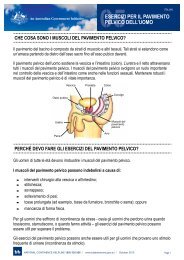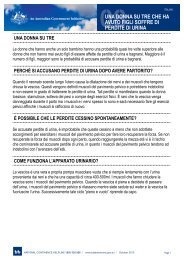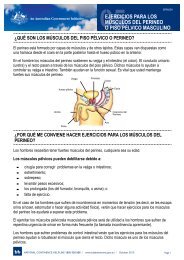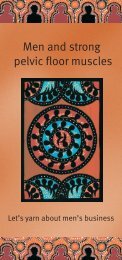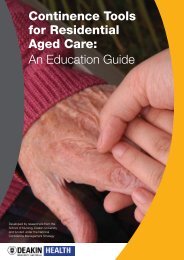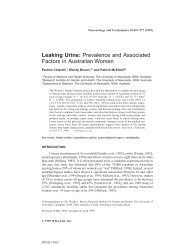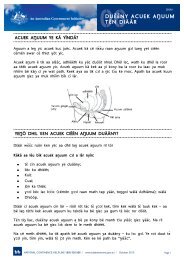Pharmacy Continence Care - Bladder and Bowel Website
Pharmacy Continence Care - Bladder and Bowel Website
Pharmacy Continence Care - Bladder and Bowel Website
You also want an ePaper? Increase the reach of your titles
YUMPU automatically turns print PDFs into web optimized ePapers that Google loves.
NOVA initially proposed to recruit 50 participating pharmacies from across four states <strong>and</strong><br />
territories, including rural <strong>and</strong> remote pharmacies <strong>and</strong> pharmacies in areas of high migrant<br />
populations.<br />
A brief notification of the pilot Program announcing the opportunity for pharmacies to<br />
participate was placed in the <strong>Pharmacy</strong> Guild e-newsletter in November 2004. A number of<br />
pharmacies contacted the NOVA Team for further information about the pilot <strong>and</strong> around 30<br />
volunteered to participate. Other avenues used to recruit pharmacies included:<br />
• approaching State branches of the <strong>Pharmacy</strong> Guild (ACT Guild)<br />
• seeking participants from other Commonwealth-funded projects (participants in the<br />
Divisions of GP program in Tasmania <strong>and</strong> Victoria, <strong>and</strong> the Hunter <strong>Continence</strong> <strong>Care</strong><br />
project in NSW)<br />
• team members cold-canvassing, in person <strong>and</strong> by phone, pharmacies in Canberra,<br />
Sydney <strong>and</strong> Melbourne.<br />
A total of 51 pharmacies volunteered to participate. These are listed in Appendix 1.3.<br />
<strong>Pharmacy</strong> training methodology involved initial design <strong>and</strong> administration of an initial<br />
interview of each participating pharmacy at entry to the Program that included identification<br />
of preferred modes for training. Training methods <strong>and</strong> modalities were assessed <strong>and</strong><br />
selected, an external training provider appointment. Training of the trainers was undertaken<br />
<strong>and</strong> a training schedule for all pharmacies established.<br />
Training kits were distributed to each participating pharmacy <strong>and</strong> the training provider<br />
provided training for each pharmacy, through face-to-face, self-paced, telephone-based or<br />
group training. During the training sessions, pharmacies were provided with information <strong>and</strong><br />
encouraged to undertake a number of activities that would contribute to continence care for<br />
their customers. These recommended activities included:<br />
• providing information on incontinence <strong>and</strong> its management to customers (in accordance<br />
with Professional Practice St<strong>and</strong>ard PPS 1 in the QCPP program. A pack of consumer<br />
materials was provided to pharmacies including counter talkers (in the form of a business<br />
cards), stickers to be placed on relevant products, posters to be displayed in the<br />
pharmacy, pamphlets on incontinence issues <strong>and</strong> a specially produced edition of Bridge,<br />
the magazine of the <strong>Continence</strong> Foundation of Australia<br />
• providing counselling on continence management issues as required or requested. The<br />
messages to be conveyed included incontinence may affect both men <strong>and</strong> women, it is<br />
not an inevitable consequence of ageing, <strong>and</strong> it should be managed appropriately.<br />
Pharmacies were provided with information <strong>and</strong> training on self-help strategies <strong>and</strong><br />
management options that could be used by consumers to assist them to make informed<br />
choices <strong>and</strong> to take action<br />
• providing information to customers on medications that may exacerbate incontinence or<br />
predispose a person to it, <strong>and</strong> medications that may alleviate symptoms.<br />
The degree to which pharmacies implemented these components of the Program is analysed<br />
in Chapter 4 of this report.<br />
At the end of training, the project team <strong>and</strong> the training provider reviewed the<br />
appropriateness <strong>and</strong> effectiveness of training, <strong>and</strong> sought post-training self-evaluation<br />
reports by facsimile from each pharmacy, together with a Program-supplied tax invoice for<br />
an incentive <strong>and</strong> compensation payment of $350 plus GST in contribution to the pharmacy<br />
costs for participation in the training <strong>and</strong> pilot Program preparation.<br />
Final Report<br />
7<br />
NOVA Public Policy<br />
<strong>Pharmacy</strong> <strong>Continence</strong> <strong>Care</strong> Project



